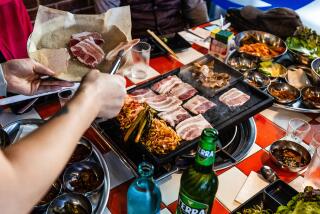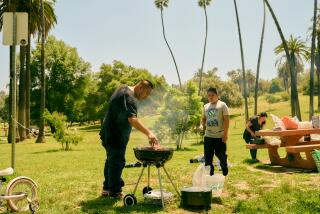3 Tips for Better Barbecue: Patience, Practice and Preparation
- Share via
Chef Buddy Hungerford recalls the time that a friend tried to barbecue a whole pork butt and wound up with a bonfire instead.
It was “one of those (get-togethers) where you’re cooking outside and drinking inside and you go back out and your barbecue’s afire,” Hungerford says with a laugh. Pork butt is a fatty cut of meat and “the fat just dripped right down in the charcoals and (ignited). We had to get the fire extinguisher.”
Not all barbecue mistakes are this spectacular, but many back-yard chefs find barbecuing a hit-and-miss proposition (anyone who has suffered through raw hamburgers or steaks charred beyond recognition can testify that it is not an easily mastered art).
That is why the experts say that those who are really serious about barbecuing need to remember the three “Ps”--patience, practice and preparation.
“Let’s say we have a standard barbecue at home, that we’re going to do chicken breasts,” says Hungerford, a graduate of the Culinary Institute of America and executive chef at Caliente in Irvine.
A common error is to jump the gun, he says, to start before the fire has cooled properly or to bathe the raw meat in sauce. Hungerford says the fire--whether gas or charcoal--should be a medium heat, not too hot to hold your hand over for 5 to 10 seconds. And to avoid burning, the chicken breasts should be cooked at least a minute on each side before any sauce is applied.
He says a general rule of thumb is to apply barbecue sauce only once during cooking, either halfway through the process or at the end, and to apply it sparingly. Extra sauce can always be served on the side.
(Many cooks sidestep all the problems by baking the chicken beforehand, marinating it in barbecue sauce and using the barbecue grill to singe and heat before serving.)
Jim Traywick, general manager of R.J.’s The Rib Joint in Newport Beach and a connoisseur of the Southern-style barbecue of his youth, stresses the importance of patience.
“Cook it slow and low,” Traywick says. “We cook our ribs here at 250 degrees for 3 1/2 hours. To get the true Southern barbecue, you need that longer period of time to get the meat to be tender and to have the smoky flavor that you want.”
He points out that meat dries when cooked at high temperatures while slow cooking produces a self-basting process that keeps it moist.
Learning how to regulate a fire is a key to successful barbecues, the experts agree. Traywick suggests purchasing an inexpensive oven thermometer (available in most grocery stores) and using it to monitor charcoal temperature, adding coals as needed.
He also recommends a meat thermometer to check the internal temperature of poultry, inserting it into the thickest part of the chicken or turkey and being careful not to touch bone. “Once it reaches 160 degrees, it’s done,” he said.
Christian Rassinoux, who began cooking in his native Paris, France, and is now executive chef at the Ritz-Carlton in Dana Point, prefers to test the doneness of meat by practiced touch.
“If the meat is very soft,” he says, “the meat will be rare. If it’s harder, it will be medium, and if it has a hard touch, it’s well done.
“On chicken, I would suggest that if you are not sure of the result, make an incision in it. If you see some blood coming out, that means the chicken is not done.”
Rassinoux notes that many people have difficulty barbecuing fish, which he says requires “a very, very clean barbecue,” a hot fire and brushing the fish lightly with oil to prevent sticking.
“It’s also better for fish to have the skin on,” he says, “unless you have a thick steak of bass or halibut or tuna.”
(Another method of preventing the fish from sticking to the grill is to place the fish on aluminum foil on the grill for a few minutes and then slip the foil out.)
Rassinoux points out that the time it takes for the coals to cool down also allows the starter fluid to fully dissipate. He suggests you wait at least 30 minutes before you put the food on the grill.
And if it’s a distinctive flavor you want, he recommends sprinkling a few fresh herbs, such as rosemary, on the coals, or using mesquite or hickory chunks or chips in the fire.
The chips, which can be used with charcoal or gas barbecues, should be soaked in water for an hour, put in a shallow dish or pan and placed on the cooler side of the fire and not directly under the meat, Traywick says. They will slowly smolder and give meat a smoked flavor.
Marinades also can provide zesty flavor, in addition to acting as tenderizers when the meat is left in them for 24 hours.
Rassinoux recommends a simple marinade of olive oil, fresh herbs, onion and a touch of sherry, or perhaps olive oil with roast garlic, lemon, thyme or rosemary.
For many people, barbecue just isn’t barbecue without sauce, and practice and preference are what’s important here.
“In California,” Traywick says, “people tend to lean a little more toward the sweeter barbecue.” He suggests taking a “store-bought” sauce and experimenting by adding honey, orange juice, onions, pickle relish or even chocolate--whatever appeals to your taste buds.
He also suggests reading “The All-American Barbecue Book” ($8.95, Vintage Press) by Rich Davis and Shifra Stein.
Of all the barbecue books he owns, this is Traywick’s favorite because it gives a comparison survey of how barbecue differs from region to region across the country and includes different sauces. “And it’s got recipes from some of the most famous barbecue houses in the United States,” he says.
More to Read
Eat your way across L.A.
Get our weekly Tasting Notes newsletter for reviews, news and more.
You may occasionally receive promotional content from the Los Angeles Times.










